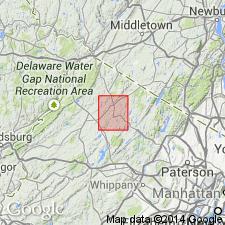
- Usage in publication:
-
- Hardistonville quartzite*
- Modifications:
-
- Named
- Dominant lithology:
-
- Quartzite
- AAPG geologic province:
-
- Appalachian basin
Summary:
Hardistonville quartzite, here named, is oldest fossiliferous rock of region [Sussex Co., NJ]. Olenellus age was established by Beecher and Nason. Usually bluish gray when fresh; weathers yellow or brown. Often porous and limonitic and frequently contains considerable pyrite. Varies in coarseness from fine conglomerate to quartzite. Shaly phase often present in upper part. Thickness 1 to 30 ft. Grades into overlying Wallkill blue limestone [Kittatinny limestone]. Overlies Franklin white limestone. Exposed at brook section in Hardistonville and on hill 1 mi south of Hardistonville.
Source: GNU records (USGS DDS-6; Reston GNULEX).
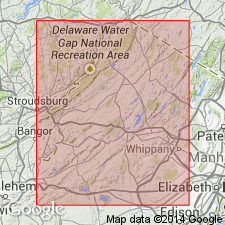
- Usage in publication:
-
- Hardiston quartzite
- Modifications:
-
- Revised
- AAPG geologic province:
-
- Appalachian basin
Summary:
Unit described and named Hardistonville quartzite by Wolfe and Brooks, here changed to Hardiston quartzite. The shorter name is that of the township and according to the authors seems preferable. Unit consists of (descending): 1) 10 to 15 ft of sandy shales (transition beds), 2) 15 ft of sandy limestone, 3) sandstone or quartzite of variable composition and thickness, usually blue gray when fresh, but some beds are light yellow brown and others nearly white. Thickness 100 to 140 ft if transition beds at top are to be included. The conglomeratic phase is known to exceed 100 ft at a number of localities. Lower Cambrian trilobites found in the calcareous sandstone beds. No fossils in the vitreous quartzites or the arkose beds. Conformably underlies Kittatinny limestone. Rests on Precambrian crystallines.
Source: GNU records (USGS DDS-6; Reston GNULEX).
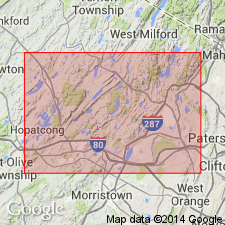
- Usage in publication:
-
- Hardyston quartzite
- Modifications:
-
- Revised
- AAPG geologic province:
-
- Appalachian basin
Summary:
Spelling of name changed to Hardyston, to conform to the adopted spelling of the U.S. Geographic Board.
Source: GNU records (USGS DDS-6; Reston GNULEX).
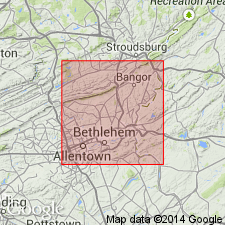
- Usage in publication:
-
- Hardyston formation
- Modifications:
-
- Areal extent
- Revised
- AAPG geologic province:
-
- Appalachian basin
Summary:
Unit extended into Northampton Co., PA, as Hardyston formation, replacing Leithsville. Overlies Precambrian crystalline formations and underlies Tomstown formation.
Source: GNU records (USGS DDS-6; Reston GNULEX).
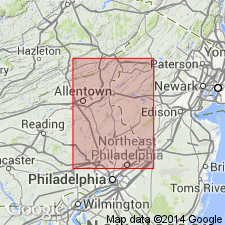
- Usage in publication:
-
- Hardyston quartzite
- Modifications:
-
- Areal extent
- AAPG geologic province:
-
- Appalachian basin
Summary:
Chickies quartzite used rather than Hardyston in Buckingham area, PA. Hardyston reserved for those areas where Lower Cambrian quartzite can be closely correlated with type formation in NJ.
Source: GNU records (USGS DDS-6; Reston GNULEX).
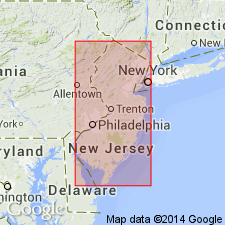
- Usage in publication:
-
- Hardyston Formation
- Modifications:
-
- Overview
- AAPG geologic province:
-
- Appalachian basin
Summary:
Where the Hardyston is more than 50 ft thick, it typically forms a narrow to broad bench atop the slope surface above the valley bottom. Unit varies in lithology and color, but is generally composed of a vitreous, light pink, steel gray or brown, locally arkosic, fine to coarse-grained, resistant quartzite. Pebble conglomerate common at base. Locally, where the unit is less than 10 ft thick, it is a fine- to medium-grained, gray, pyritic quartzite, grading into a dark-gray dolomitic sandstone. Hardyston unconformably overlies Precambrian crystalline rocks where it was deposited on an irregular surface and fills only the troughs ore depressions. Gradationally underlies the Leithsville Formation. Age is Early Cambrian.
Source: GNU records (USGS DDS-6; Reston GNULEX).
For more information, please contact Nancy Stamm, Geologic Names Committee Secretary.
Asterisk (*) indicates published by U.S. Geological Survey authors.
"No current usage" (†) implies that a name has been abandoned or has fallen into disuse. Former usage and, if known, replacement name given in parentheses ( ).
Slash (/) indicates name conflicts with nomenclatural guidelines (CSN, 1933; ACSN, 1961, 1970; NACSN, 1983, 2005, 2021). May be explained within brackets ([ ]).

